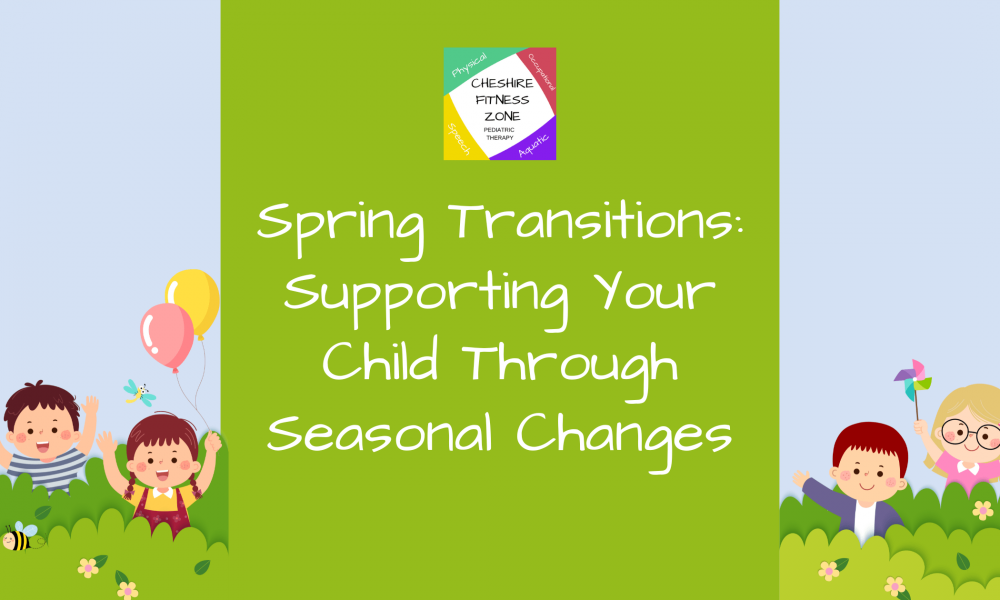Spring Transitions: Supporting Your Child Through Seasonal Changes
As the seasons change, so do daily routines, activities, and sensory experiences. Spring brings longer daylight hours, unpredictable temperatures, and a shift from indoor to outdoor play. While this can be an exciting time, it can also be challenging for kids. Whether it’s adjusting to the longer days, navigating changes in clothing, or preparing for new routines, here are some ways to support a smooth transition into spring!
Adjusting to Longer Days
With the sun staying out later, bedtime routines can feel off. Some kids may have trouble settling down at night, while others might wake up earlier than usual. Sleep schedules can easily get thrown off, and when kids aren’t well-rested, it can impact their focus, mood, and ability to regulate emotions during the day.
To help keep things consistent, try using blackout curtains to make the room feel darker at bedtime. Sticking to the usual pre-bedtime routine, whether it’s reading a book, stretching, or a quiet activity, can also signal that it’s time to wind down. If bedtime needs to shift, try adjusting it gradually by 10 to 15 minutes each night to make the change feel smoother.
For kids who have trouble settling at night, adding in sensory strategies like a weighted blanket, deep-pressure input (like big hugs or gentle squeezes), or calming music can help promote relaxation.
Navigating Changing Weather
Spring weather can be unpredictable. The transition from heavy winter clothes to lighter layers can be tough for kids who are sensitive to textures or temperature changes. Some kids may resist wearing short sleeves or feel uncomfortable in new fabrics, while others might get overwhelmed by the feeling of warmer temperatures.
Talking about the weather changes ahead of time and letting kids choose between a couple of clothing options can make the transition easier. Practicing wearing spring clothes indoors before heading out can also help kids get used to the different sensations. If warm weather feels overwhelming, carrying a water bottle, choosing breathable fabrics, or taking breaks in shaded areas can provide some relief.
For kids working on self-dressing skills, making it fun can help build independence. Try using a mirror, breaking down each step into smaller parts, and celebrating small successes along the way.
Encouraging Outdoor Play
After spending more time indoors during the colder months, spring is the perfect time to get outside and move. Outdoor play is not just great for burning off energy, it also helps build motor skills, coordination, and social interactions. Running, climbing, and jumping at the playground can strengthen muscles and improve balance, while activities like sidewalk chalk, bubbles, or scavenger hunts help develop fine motor and visual-motor skills.
Some kids may need time to adjust to new outdoor environments, especially if they get overwhelmed by busy playgrounds or the feeling of grass or sand. Starting with shorter outdoor play sessions and slowly increasing time outside can help. Bringing along a favorite toy, blanket, or comfort item can also provide a sense of familiarity.
If your child is working on physical or occupational therapy goals, outdoor activities can be a fun way to incorporate movement and strength-building. Ask your therapist for activity ideas that match your child’s goals and interests.
Transitioning to New Routines
Spring often brings changes in schedules, whether it’s school field trips, new sports, or more social activities. For kids who thrive on predictability, these shifts can sometimes feel overwhelming. Having a plan in place can make transitions easier and help kids feel more prepared.
Using a visual schedule or social stories to explain new activities can give kids a better understanding of what to expect. Practicing transitions ahead of time, like using countdowns or timers, can also help when moving from one activity to the next. And while spring can be an exciting time with lots of new opportunities, it’s just as important to build in some downtime to prevent overstimulation.
With more social activities in the mix, spring is also a great time to support communication skills. Practicing how to ask questions, express feelings, or navigate new social situations can help kids feel more confident in group settings.
Embracing the Season
Spring is all about change, and while change can be tough, it also brings new opportunities for growth. Whether it’s adjusting to the longer days, getting used to the warmer weather, or navigating new activities, small steps can make a big difference. By incorporating therapy-friendly strategies into daily routines, you can help your child feel more comfortable and confident as they transition into the season. And if you ever need extra support, your team at Cheshire Fitness Zone is always here to help!



